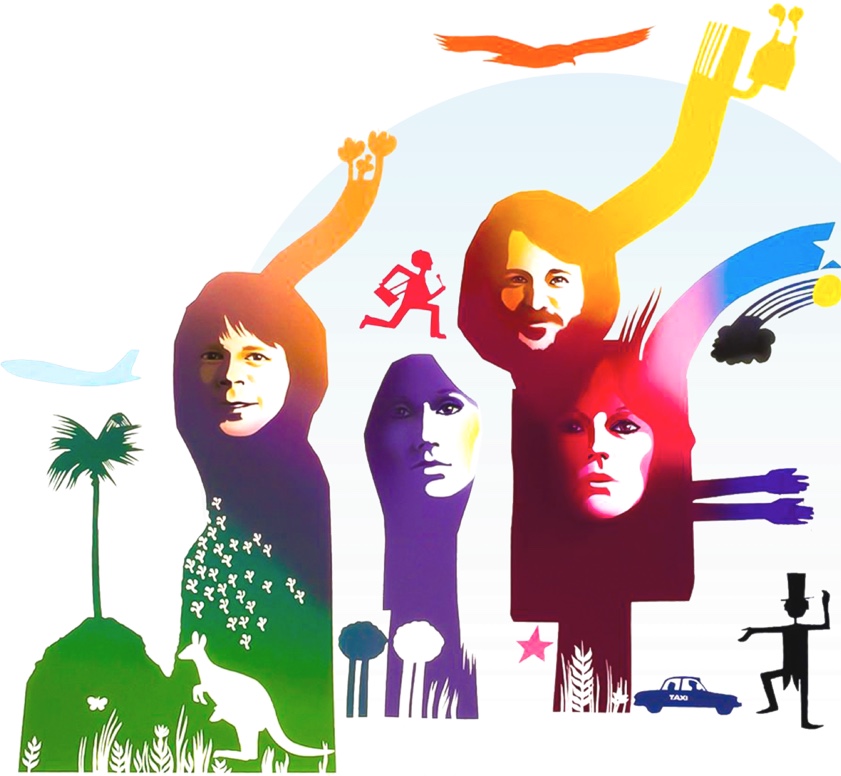In focus: Lycka – the only Björn & Benny album
The Björn Ulvaeus and Benny Andersson album Lycka, released in 1970, contained the very first song to feature all four ABBA members: Hej gamle man! (“Hey Old Man!”). As the original album is reissued on CD with 14 bonus tracks, we explore the fascinating era between Björn and Benny’s years as Sixties pop stars and the first ABBA recordings.
First Inga, then Happiness
 The year 1969 was a crucial turning-point in the ABBA saga. That was the year when Benny Andersson’s group, The Hep Stars, split, and it was the year when the Hootenanny Singers, Björn Ulvaeus’ band, decided to quit touring for the foreseeable future, confining their infrequent group activities to the recording studio. It was also the year when Björn became romantically involved with Agnetha Fältskog, and Benny was engaged to Anni-Frid Lyngstad. Björn and Benny strengthened their working partnership as songwriters and producers, and solidified their connection with Stig Anderson of the record company Polar Music; he also contributed lyrics to many of their songs. In hindsight, it seems the scene was set for ABBA to happen, whenever those involved felt so inclined. The reality at the time, however, was quite different.
The year 1969 was a crucial turning-point in the ABBA saga. That was the year when Benny Andersson’s group, The Hep Stars, split, and it was the year when the Hootenanny Singers, Björn Ulvaeus’ band, decided to quit touring for the foreseeable future, confining their infrequent group activities to the recording studio. It was also the year when Björn became romantically involved with Agnetha Fältskog, and Benny was engaged to Anni-Frid Lyngstad. Björn and Benny strengthened their working partnership as songwriters and producers, and solidified their connection with Stig Anderson of the record company Polar Music; he also contributed lyrics to many of their songs. In hindsight, it seems the scene was set for ABBA to happen, whenever those involved felt so inclined. The reality at the time, however, was quite different.
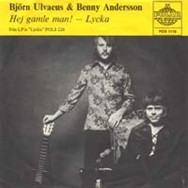 In Sweden, the late Sixties and early Seventies were a difficult period for former pop stars such as Benny and Björn. The first, innocent pop era collapsed when the discotheques became popular and killed off many gig opportunities. “Pop” became “rock” and there were demands for a “heavier” and more advanced musical setting; also, the lyrics had to deal with philosophical or political issues if artists wanted to be taken seriously. Those who wanted to devote themselves to pure entertainment found it tough: the market for Swedish light-pop was limited, so what remained was Swedish schlager (a form of European easy listening) and cabaret. That was how the duo Björn and Benny kept themselves afloat, although they dreamed about an international career in English-language pop. Stig Anderson was confident that their dream would come true: “One day you will write a song that becomes a worldwide hit!”
In Sweden, the late Sixties and early Seventies were a difficult period for former pop stars such as Benny and Björn. The first, innocent pop era collapsed when the discotheques became popular and killed off many gig opportunities. “Pop” became “rock” and there were demands for a “heavier” and more advanced musical setting; also, the lyrics had to deal with philosophical or political issues if artists wanted to be taken seriously. Those who wanted to devote themselves to pure entertainment found it tough: the market for Swedish light-pop was limited, so what remained was Swedish schlager (a form of European easy listening) and cabaret. That was how the duo Björn and Benny kept themselves afloat, although they dreamed about an international career in English-language pop. Stig Anderson was confident that their dream would come true: “One day you will write a song that becomes a worldwide hit!”
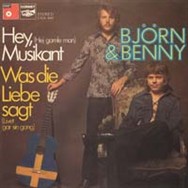
Despite this setback, it was decided that Björn and Benny should record an entire album. As early as the summer of 1969 there had been talk of a demo album, for the purpose of attracting other artists to record Andersson/Ulvaeus compositions, but the plans weren’t realised until the following year. Also, it was decided to make it a “real” album for commercial release, even if there was still the hope that there would be cover versions of the songs. The album, eventually entitled Lycka (“Happiness”), was recorded between June and September 1970, although according to a contemporary interview with Björn Ulvaeus, only five days in total was spent in the studio for the 11 tracks on the album. In terms of style, the album was fairly eclectic: intimate ballads were followed by somewhat rawer electric guitar-based pop (the rocky ‘Nånting är på väg’ [“Something’s On The Way”] had appeared in an instrumental version in The Seduction Of Inga), which in turn was followed by folk-pop and perky schlager songs. But in general the album was characterised by a sort of singer/songwriter ambition, as if Björn and Benny wanted to become a Swedish version of Simon and Garfunkel.
Two young couples and one old man
However, it was not the more poppy material, rooted in the music revolution of the Sixties, that would give the duo their greatest success. When title track of the album, the ballad ‘Lycka’ – featuring Stig Anderson’s lyrics about simple, everyday happiness – was released as a single A-side, it was the Salvation Army-style flipside, ‘Hej gamle man!’, that became the hit. On the important radio chart Svensktoppen (“The Swedish Top Ten”) it was number one for five weeks, and the single reached number five on the sales chart. In all likelihood, the success of ‘Hej gamle man!’ was partly down to the fact that Agnetha and Frida appeared on backing vocals. The idea for a collaboration between the four had been born in the spring of 1970, when Benny and Frida accompanied Björn and Agnetha on their engagement trip to Cyprus. During their holiday they sang together and were struck by the extraordinary sound they made as a quartet. Their first plan was for a cabaret show in the autumn, but in the meantime they recorded ‘Hej gamle man!’ – the first time all four appeared on the same disc. “It was the birth of ABBA in a way,” Frida recalled many years later. “I don’t think it would have become such a hit if Agnetha and I hadn’t been on it.”
Stig Anderson, always diligent in his efforts to try to sell Björn and Benny’s music abroad, managed to secure a West German recording of ‘Hej gamle man!’ Recorded in January 1971, the single ‘Hey Musikant’, backed with ‘Was die Liebe sagt’ (a translation of ‘Livet går sin gång’ [“Life Just Goes On”]), did not become a hit, however. Nor did Lycka have much success as a demo album for other artists. Most of the cover versions that were recorded had a strong connection to Benny, Björn and Stig. For instance, Polar recording artist Lena Andersson recorded an English version of the ballad ‘Livet går sin gång’, entitled ‘Language Of Love’ (it was also said that French songstress Françoise Hardy was to record a version, but no such recording seems to exist), while her label mates Svenne and Lotta issued an English-language version of ‘Kära gamla sol’ (“Dear Old Sun”) entitled ‘Roly-Poly Girl’ on an album in 1975. Frida did a highly impressive version of ‘Lycka’ on her Benny-produced debut album, Frida, issued in 1971.
The cabaret show put together by the two engaged couples under the name Festfolk premiered in Gothenburg on November 1, 1970, but unfortunately it became a big flop. Notably, one of the few numbers to evoke fond memories in the ABBA members today is ‘Hej gamle man!’, which appeared in the show with alternate lyrics, entitled ‘Tyck om varann’ (“Care For Each Other”). But although this would have strengthened the resolve to go on working as a quartet, the subsequent tour with the show was not an enjoyable experience and effectively killed those plans. In the meantime, however, they all contributed to the records they each issued as solo or duo acts, whether as producers, musicians, backing vocalists or songwriters. One example of such a collaboration was the next Björn and Benny single, ‘Det kan ingen doktor hjälpa’ (“There’s No Cure For That”), which again featured backing vocals by Agnetha and Frida, as did its flipside ‘På bröllop’ (“At A Wedding”), although none of the songs became a hit of any particular note.
Björn and Benny had better luck with their next single, the ballad ‘Tänk om jorden vore ung’ (“Imagine If The World Were Young”) – also with Agnetha and Frida on back-up vocals – which spent two weeks at the top of the Svensktoppen chart in December 1971. The song is notable for being one of the few in the history of recorded music to include solo vocal parts from Benny. He is also featured on the Lycka album’s ‘Kära gamla sol’ and he has solo parts on the 1972 single ‘En karusell’. His last solo number to date is ABBA’s ‘Suzy-Hang-Around’ on the 1974 Waterloo album (there is also a brief solo vocal on the snippet of ‘Here Comes Rubie Jamie’, included in the ABBA Undeleted medley on the box sets Thank You For The Music and The Complete Studio Recordings). The B-side of ‘Tänk om jorden vore ung’ was entitled ‘Träskofolket’ (“The Clog People”), inspired by the same series of Swedish “Emigrant” novels that would result in the Andersson/Ulvaeus hit musical Kristina från Duvemåla (“Kristina From Duvemåla”) more than two decades later.
A Japanese kind of girl

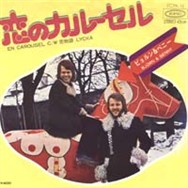
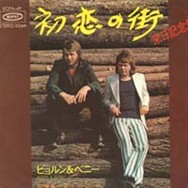
Duos have their ways
In Japan, ‘Merry-Go-Round’ was issued as an A-side, but credited to Björn and Benny only. Furthermore, it was a different mix of the song than the one issued by ABBA. The B-side of the Japanese single was ‘Tänk om jorden vore ung’, in Swedish. However, when the single was issued there was quite a bit of confusion: the A-side acquired the “Swenglish” title ‘En carousel’ while the B-side somehow was labelled as another song altogether: ‘Lycka’! To confuse matters even more, in Sweden ‘Merry-Go-Round’ was issued as the Swedish-language Björn and Benny single ‘En karusell’. However, the single B-side, ‘Att finnas till’ (“To Exist”), actually became the bigger hit.
‘Merry-Go-Round’ failed to repeat the success of ‘She’s My Kind Of Girl’ in Japan. Therefore, the Japanese record label felt that they should contribute a melody of their own for the Swedes to record, something that was closer to the melancholy tones of ‘She’s My Kind Of Girl’. The writing of the lyrics was entrusted to Björn and Benny themselves, although with the instruction that the theme had to be “lost love”. At the end of August 1972, the duo recorded their third and final Japanese single: ‘Love Has Its Ways’. The B-side featured ‘Rock’n Roll Band’, which would later acquire backing vocals from Frida and Agnetha and be included on the first ABBA album, Ring Ring.
‘Love Has Its Ways’ did not become much of a hit, however. After a November visit to a song festival in Tokyo, together with Agnetha and Frida, Björn and Benny’s Japanese adventures came to an end. However, this didn’t matter so much at the time, for the duo had other projects in the works. ‘People Need Love’ had been a fairly impressive success in Sweden – it was the first time in several years that Benny and Björn achieved a true pop hit – and so it was decided at Polar that the constellation of Björn and Benny, Agnetha and Frida would record an entire album together. Sessions began in the autumn of 1972 (which also meant that the second Björn and Benny album was cancelled). Around the same time, Björn, Benny and Stig were invited to submit a contribution to the Swedish selection for the 1973 Eurovision Song Contest. The group competed with ‘Ring Ring’ in February 1973 and released their debut album the following month, which meant that the ABBA story began for real – but this is where our tale takes off in a direction that is not directly connected to the Björn and Benny duo.
For although June 2006 marks the 40th anniversary of Benny Andersson and Björn Ulvaeus’ first meeting and subsequent songwriting effort, and their collaboration is the main thread of everything they’ve done musically since then, the recording duo Björn and Benny ceased to exist in 1972. However, the remastered CD version of Lycka offers a previously unreleased bonus track, which was probably recorded in the mid-Seventies. Shortly after the release of the original album, the title track acquired English lyrics by Ernie Sheldon, entitled ‘To Live With You’, although it seems the song was never issued with those lyrics. For reasons that are unclear today – perhaps there was a thought that ABBA could record the song, or maybe some foreign publisher wanted to hear the song – the Björn and Benny duo was temporarily resurrected in the mid-Seventies to record a simple demo of the song with its English lyrics. This demo of ‘To Live With You’ is now released for the very first time.
(Single sleeves kindly supplied by Pepe.)
